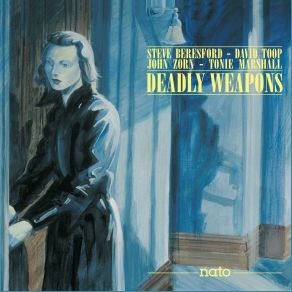Deadly Weapons
Download links and information about Deadly Weapons by Steve Beresford, John Zorn, David Toop. This album was released in 1986 and it belongs to Jazz genres. It contains 11 tracks with total duration of 38:11 minutes.

|
|
|---|---|
| Artist: | Steve Beresford, John Zorn, David Toop |
| Release date: | 1986 |
| Genre: | Jazz |
| Tracks: | 11 |
| Duration: | 38:11 |
| Buy it NOW at: | |
| Buy on iTunes $9.99 | |
Tracks
[Edit]| No. | Title | Length |
|---|---|---|
| 1. | Shockproof | 8:13 |
| 2. | Du gris | 3:17 |
| 3. | King Cobra | 4:49 |
| 4. | Tallulah | 3:22 |
| 5. | Dumb Boxer | 2:15 |
| 6. | Lady Whirlwind | 0:47 |
| 7. | Shadow Boxer | 3:03 |
| 8. | Sitting in the Park | 1:38 |
| 9. | Snow Blood | 2:31 |
| 10. | Chen Pe'i Pe'i | 3:12 |
| 11. | Jayne Mansfield | 5:04 |
Details
[Edit]This collective of jazz improv weirdoes banded together for a one-off in 1986 to riff on the deep vibe of all things French and cinematic. Backing vocalist Toni Marshall, Zorn, Beresford, and Toop created a virtual and highly experimental film noir soundtrack to a movie that perhaps existed in the mind of Jean-Luc Godard in the 1950s, but was never made. Toop is clearly the sonic architect here, haunting the proceedings with his deep use of effects, subdued percussion, and strategically placed guitars among the keyboards and Zorn's unmistakable alto. The set beings with a theme written around a narrative by Benjamin Peret, and comes out of the box as a R&B vamp that paints a picture of foggy wharfs, smoky bars, and people in trench coats. It gives way quickly, however, to a noisier kind of meditation that somehow keeps the vibe. As we move through "Du Gris" and Zorn's "King Cobra," the textured and sampled passages become more pronounced but the eerie, foreboding feeling remains. When Marshall begins, in her grainy, soft voice, to sing the gorgeous "Tallulah," — one of two tributes to actresses here, the other is to Jayne Mansfield — the effect is complete as we enter into a dreamy soundscape of pure cinéma vérité. From here on, the listener has fully entered a landscape that is familiar yet somehow strange, as if the color mix were off on a TV or movie screen. We can understand the images but not the language, and there are no subtitles. And that's what this quartet is going for, a manner of creating musical images that are outside the specific languages they employ in the architecture of their chosen sounds. By the time the end credits roll (on "Jayne Mansfield"), this quartet has done what so many attempt, but so few actually succeed at: They've created a virtual cinema of the unconscious, colored by sound yet evoking not only images but sounds, feelings, and textural awareness; beautiful and harrowing.